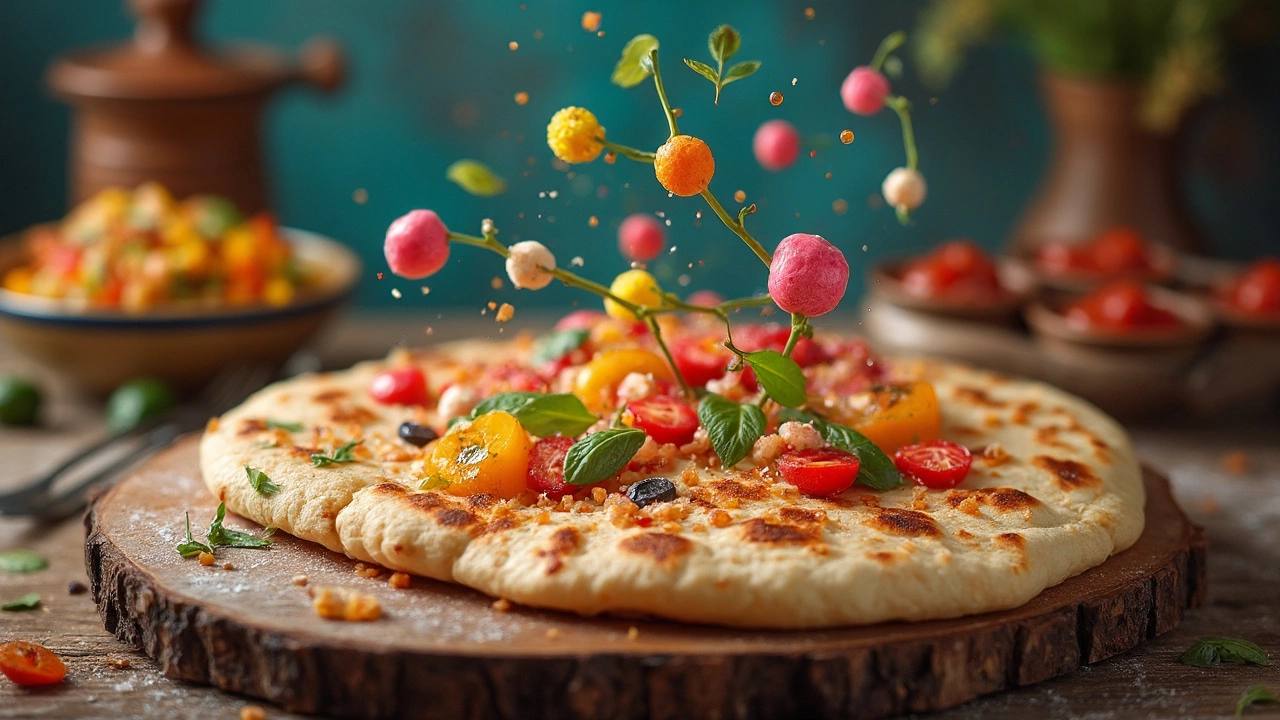When it comes to Indian bread, naan is like the rock star—it's everyone's favorite sidekick to a buttery curry or spicy tandoori dish. But did you know it has its downsides, too? One major drawback is the calorie content. Naan is made with refined flour, often brushed with butter or ghee, which can bump up those calorie numbers faster than you can say 'paratha.' If you're watching your waistline, that fluffy bread might be a sneaky culprit.
But calories aren't the only concern. Naan doesn't score high on the nutrition scale. It's not just the carbs; there's not much fiber, vitamins, or minerals in there. This isn't a big deal if it's a once-in-a-blue-moon treat, but if naan's a regular on your plate, it might be time to rethink it.
- The Caloric Cost of Naan
- Nutritional Gaps
- Dietary Restrictions and Naan
- Healthier Homemade Options
- Smart Pairings and Substitutions
The Caloric Cost of Naan
Let's face it, a warm piece of naan is irresistible. But what does it really cost you? Calorie-wise, quite a bit. A single piece of plain naan can pack around 200 to 300 calories. And that's just for the plain version. Add some butter or garlic, and it quickly gets even higher.
According to Dr. Mirriam Joseph, a nutritionist at the Institute of Diet and Wellness, "Naan can often be deceptively caloric, thanks to the refined flour and added fats like butter and ghee. It's important to be aware of this if you're monitoring your daily intake."
Now, why is this a problem? Most people don't just stop at one piece. When you're scooping up that curry or topping it with a bit of chutney, a second or even third piece can slip onto your plate, right? It's easy to underestimate the caloric load.
To give you a clearer picture, here's a quick rundown of some popular naan variations and their typical calorie content:
| Type of Naan | Average Calories |
|---|---|
| Plain Naan | 200-300 |
| Butter Naan | 250-350 |
| Garlic Naan | 260-320 |
| Cheese Naan | 300-400 |
Knowing this, what can you do? Well, for starters, moderation is key. Consider enjoying naan as an occasional treat rather than a daily staple. You might also explore making healthier homemade options, like whole-wheat naan or those made with yogurt instead of just oil or butter. That way, you can still enjoy its deliciousness without the side of guilt.
Nutritional Gaps
Alright, let's chat about what's missing when you bite into a piece of naan. This delicious Indian bread is known for its soft texture and yummy taste, but when it comes to nutritional value, it's not exactly a powerhouse. One of the main issues with naan is that it's made from refined wheat flour, which means it lacks the fiber that whole grains offer. Fiber is crucial for digestion and keeping you feeling full longer, so naan might leave you craving more after just a short while.
Another nutritional gap is the limited protein content. Since naan is mostly carbs, anyone counting on it for protein intake is out of luck. That’s why it's often paired with lentils or meats in Indian dishes, but the bread itself won't do much for your protein goals.
What About Vitamins and Minerals?
Naan isn't exactly a miner's treasure chest. Essential minerals like iron and calcium aren't found in significant amounts unless the recipe is specifically fortified, which most aren't. Vitamins are also MIA—there's not much in the way of B vitamins or anything spectacular on that front. If you're looking to round out your daily intake, naan shouldn't be your sole source.
And let's not forget about the sodium. Many naan recipes call for a good pinch of salt along with toppings like butter or cheese, which can pack in unexpected sodium levels. Monitoring sodium intake is important, especially if you're watching your blood pressure.
The Quick Nutrition Scoop
| Nutrient | Typical Content in Naan (per 100g) |
|---|---|
| Calories | 290 kcal |
| Fiber | 1g |
| Protein | 8g |
| Sodium | 617mg |
So, what's a naan lover to do? Well, consider these gaps as an invitation to jazz up your meal with more nutritionally-balanced foods. Pair your naan with a protein-rich, fiber-rich curry or consider whizzing up a veggie dip on the side. Just keep in mind: moderation and variety can keep your diet delicious and balanced.

Dietary Restrictions and Naan
Naan might be delicious, but it's not exactly the most accommodating dish if you've got dietary restrictions. For starters, traditional naan is usually made with refined wheat flour. This is bad news for anyone with a gluten intolerance or celiac disease. If that's you, eating naan could lead to some uncomfortable digestive issues.
Then there's the dairy factor. Naan dough often includes yogurt or milk, and it's finished with a brush of butter or ghee. Are you lactose intolerant or vegan? You'll need to steer clear or find an alternative recipe. Dr. Leela Reddy, a nutrition expert, says, "People with specific dietary needs should always check the ingredients of traditional foods. What seems harmless could be problematic."
Many folks are also choosing to avoid refined sugars and carbs, opting for low-carb diets. Naan doesn't fit well here either, being a bread base and all. It's worth considering this if you're cutting carbs for health reasons.
Navigating Naan Alternatives
The good news is that the world of naan isn't closed to everyone. Nowadays, you can easily find recipes and ready-made options that cater to different diets. Gluten-free naans use flours like almond or coconut, while vegan versions skip the dairy entirely. Some brands even offer naan made with higher fiber ingredients to benefit overall health.
For DIY enthusiasts, making your own naan with your specific needs in mind is quite doable. Want to try? Look for recipes online that match vegan, gluten-free, or low-carb criteria and give them a go with easy-to-find ingredients.
| Alternative | Main Ingredient |
|---|---|
| Gluten-Free Naan | Almond Flour |
| Vegan Naan | Coconut Milk |
| Low-Carb Naan | Cauliflower |
Healthier Homemade Options
Alright, if you're a naan lover but want to keep things on the healthy side, making it at home could be your best bet. Taking control of the ingredients lets you swap out the usual suspects for healthier alternatives without compromising too much on taste.
Swap the Refined Flour
Start by ditching the refined white flour. Ever tried whole wheat flour or spelt flour? They're richer in fiber and nutrients. Another cool option is using chickpea or almond flour to cut down carbs and boost the protein. You might need to adjust the moisture with these alternative flours, but that’s a small price to pay for a healthier bite.
Lighten Up the Fats
Melted butter and ghee are traditional, sure, but you can lighten things up with some olive oil or even coconut oil. It gives it a nice flavor kick without overloading on saturated fats. And if you’re feeling adventurous, try a dash of avocado puree.
Bring in the Flavor
Spice doesn’t have to come from butter alone. Throw in some garlic, cumin seeds, or chopped cilantro into the dough itself. You’ll end up with naan that has a punch, needing less oily toppings to taste great.
Step-by-Step Homemade Naan
- Mix it up: In a mixing bowl, combine 2 cups of your chosen flour, 1 teaspoon of yeast, 1 teaspoon of salt, and a pinch of sugar.
- Add liquids: Mix in 3/4 cup of warm water—that's warm, not hot—or milk along with 1 tablespoon of your chosen oil.
- Knead & rest: Knead the mixture until smooth, then let it rest covered in a warm spot for about an hour, or until it doubles in size.
- Shape time: Divide the dough into small balls and roll them out. You want them about 1/4 inch thick.
- Sizzle & serve: Cook on a hot skillet, flipping when bubbles form, until both sides are golden brown.
Homemade naan allows you to experiment with tweaks for healthier outcomes while maintaining that all-important taste. Let this culinary adventure be your first step towards delicious, guilt-free indulgence!

Smart Pairings and Substitutions
Alright, so naan is delicious, but what if you're aiming for a healthier alternative without giving up on taste? Let’s dive into some smart pairings and substitutions that can satisfy your craving without the calorie guilt.
Pairing with Nutrient-Rich Sides
First off, match your naan with sides that pack a punch in nutrients. Think chickpea-based dishes like hummus or chana masala. Chickpeas are a great source of protein and fiber, which balances out the carbohydrates from the naan.
If you’re a fan of greens, pair naan with a hearty spinach curry. Spinach is rich in iron and other essential nutrients, making your meal more balanced.
Substitute with Whole Wheat or Multigrain Naan
If you're not ready to give up naan entirely, try switching to whole wheat or multigrain naan. These options usually have more fiber, which can help keep you feeling full and support digestion.
Explore Naan Alternatives
For those ready to experiment, there are plenty of naan alternatives. Cauliflower flatbreads are gaining popularity as a low-carb option. They don't taste exactly like naan, but they can be seasoned with garlic or herbs to mimic that distinctive flavor.
You can also try making naan using almond or coconut flour if you're on a low-carb diet like keto. Although the texture might be a bit different, the calorie savings are worth it.
Fun Fact
Did you know some restaurants are now offering naan made with millet? It's less common but definitely worth a try if you stumble across it!
So, there you have it. You don't always have to say no to naan; just get a little creative with what you pair it with or how you prepare it.
